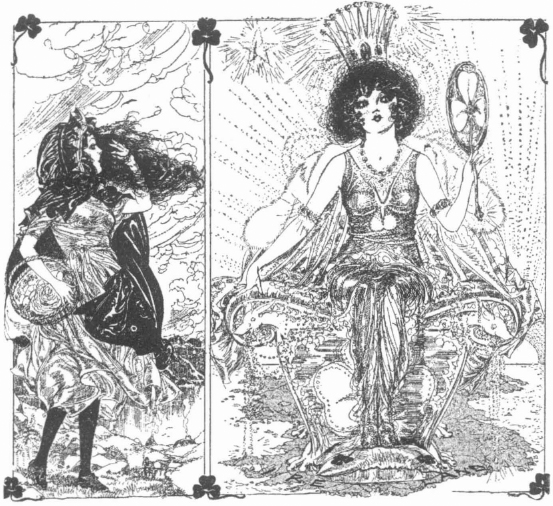
In 1922, commemorating the new Irish Free State, illustrator Nell Brinkley drew Kathleen Ni Houlihan as a poor peasant girl and as a queen upon her throne.

First published in 2004 by Conari Press,
an imprint of Red Wheel/Weiser, LLC
With offices at:
500 Third Street, Suite 230
San Francisco, CA 94107
www.redwheelweiser.com
Copyright 2004 Trina Robbins
All rights reserved. No part of this publication may be reproduced or transmitted in any form or by any means, electronic or mechanical, including photocopying, recording, or by any information storage and retrieval system, without permission in writing from Red Wheel/Weiser, LLC. Reviewers may quote brief passages.
ISBN-10: 1-57324-952-1
ISBN-13: 978-1-57324-952-2
Library of Congress Cataloging-in-Publication Data
Robbins, Trina.
Wild Irish roses : tales of Brigits, Kathleens, and warrior queens / Trina Robbins.
p. cm.
Includes bibliographical references and index.
ISBN 1-57324-952-1 (alk. paper)
1. WomenIrelandBiography. 2. IrelandBiography. I. Title.
CT3650.I73R63 2004
920.72'09415dc22
2004009755
Photographs of Maud Gonne, Countess Markiewicz, and Lady Gregory, and drawing of Lady Wilde (Speranza), courtesy of the National Library of Ireland. Cover of sheet music for The Rebel Girl, courtesy of the Labor Archives and Research Center, San Francisco State University.
Typeset in Aldus
Printed in Canada
TCP
10 9 8 7 6 5 4 3 2
The paper used in this publication meets the minimum requirements of the American National Standard for Information SciencesPermanence of Paper for Printed Library Materials Z39.48-1992 (R1997).
www.redwheelweiser.com
www.redwheelweiser.com/newsletter

CONTENTS
INTRODUCTION
You may search everywhere but none can compare to my wild Irish rose.
CHAUNCEY ALCOTT, 1899
P oets have personified Ireland as a woman, sometimes calling her the Shan Van Vocht, the poor old woman; sometimes Kathleen Ni Houlihan; and sometimes Roisin Dubh, the little dark rose. This book is a celebration of those roses: tough, independent, and beautiful Irish women who lived between myth and modernity. It spans the centuries from ancient warrior women like Skathach and Aoife, who trained the Irish hero Cuchulain (and were also his lovers), to Countess Markievicz, a warrior for twentieth-century Ireland.
And they're all goddesses! Because the goddesses of ancient Ireland were archetypesthe warrior queen, the Cailleach or crone, the muse, or personification of Irelandand because archetypes are immortal, they've been born over and over again, as women like Countess Markievicz, Maud Gonne, and Mother Jones.
In these pages you'll find Grania O'Malley, notorious sixteenth-century Irish pirate queen, keeping company with literary roses like Lady Gregory, who revived the old Irish heroes and heroines in her writings. I've included one American Beauty Rose: the mythic Scarlett O'Hara. Like her equally mythic warrior ancestress, Queen Maeve, she knew what she wanted and took it.
It was the Irish in her.
About the names: The Irish language was spoken for centuries before it was written down, and when the early Christian monks finally inscribed the words onto parchment, they tossed in as many consonants and vowels as they could. Thus, to an English speaker (or indeed, to anybody but an Irish speaker), ancient Irish names are almost impossible to pronounce. In all cases where the simplified modern spelling is available, I have used it. Medb has become Maeve, Granuaile has become Grania, and Diarmutt has become Dermot. Sometimes I had to choose which spelling to use. In researching Dervorgilla, for instance, I found seven other variations of her name: Devorgill, Derborcaill, Derbhorgill, Derbforgaille, Dervorgoyle, Dearbhfhorgaill, and Dearvorgwla!
PART ONE
BEFORE PATRICK
Women were so highly regarded in ancient Ireland that in Irish mythology, the first people to land on Irish soil were fifty women and their queen, Cessair. According to the monks who recorded these stories, Cessair was a daughter of Noah, who wouldn't let her onto his ark, so using an early DIY mentality, she built her own ship and sailed to Ireland. The women brought with them a measly three men, whom they used up pretty quickly. The only surviving man, Fintan, escaped the voracious women by turning into an eagle and witnessing all the rest of ancient Irish history, up to the coming of Saint Patrick. As for Cessair and her women, the flood caught up with them, and they all drowned.
It was a woman who gave Ireland its name. After Cessair and her women, other tribes invaded Ireland, but the last to arrive were the Milesians, ancestors of today's Irish. They found an island already populated with gods and goddesses. As the Milesian armies progressed across the land, they eventually encountered the goddess Eriu, a woman so powerful that when she threw mudballs down on them from her high hill, the mudballs turned into defending soldiers. However, she foresaw that the Milesians would eventually overthrow her people, the Tuatha De Danaan, so she made a bargain with the Milesians: I'll let your people pass, if you promise to name this island after me. And so they did.
The ancient Irish were a proud Celtic race who loved their singing, loving, and fightingand the women loved and fought just like the men. They were equal in other ways too: ancient Irish women could be lawyers and judges, could divorce and remarry if they wanted to, and could own their own property. Even into the nineteenth century, they kept their own last names after marriage. As for the fighting part, Irish women often fought side by side with their men, especially when battling Roman invaders. The Romans, who thought of women only as mothers and sex objects, were fascinated by Celtic women warriors, and wrote about them. Diodorus Siculus recorded that the women are nearly as tall as the men, whom they rival in courage, and Ammianus Marcellinus said that Irish wives were even stronger than their husbands. Warrior queens were so common among the ancient Irish that when the Roman emperor Claudius brought a group of Celtic prisoners to Rome, they thought Claudius's wife, Agrippina, was the ruler, and they ignored the emperor. For this reason, their mythology was also full of warrior queens like Maeve and the three war goddesses, Macha, Badb, and the Morrigan. And loveah, love! Old stories tell of aggressive heroines like Dierdre and Grania, who, even though engaged to kings, knew what they wantedin both cases, much younger and cuter guysand took it. Even the fierce war goddesses were not immune to love. The Morrigan came on strong to the mythic hero, Cuchulain. When he rejected her, she fought him in the form of a heifer, an eel, and a she-wolf. The battle ended on a draw, with each wounding the other, and the goddess tricked the hero into healing her. The Morrigan's sister, Macha, made the mistake of turning gentle when she fell in love with a human, with bad results for everyone involved.
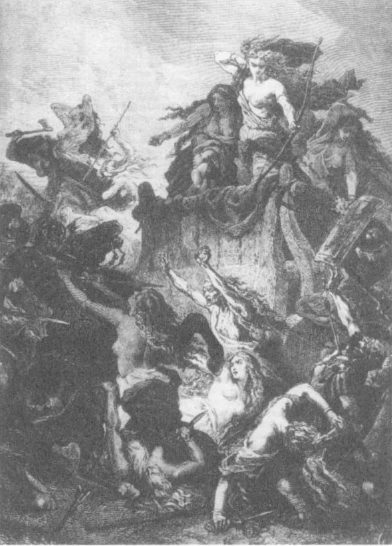
Celtic women battle Roman warriors.
Next page
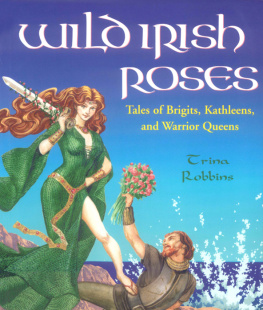

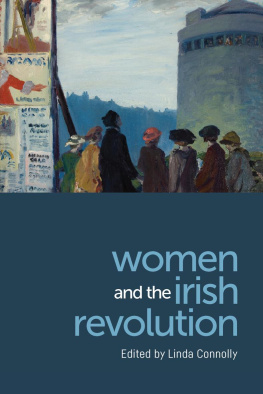
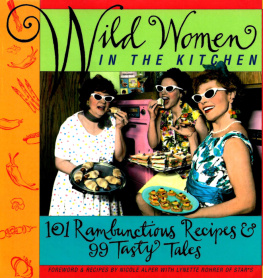

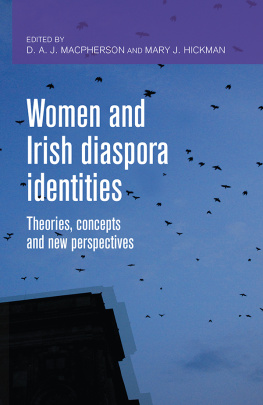
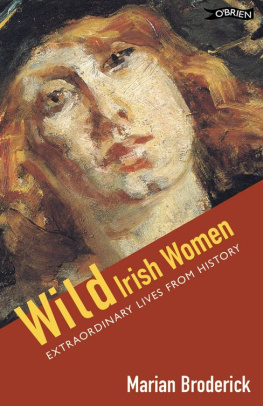
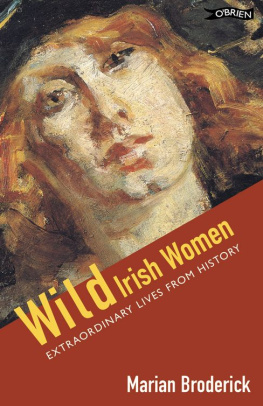

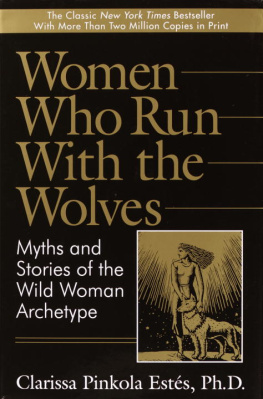
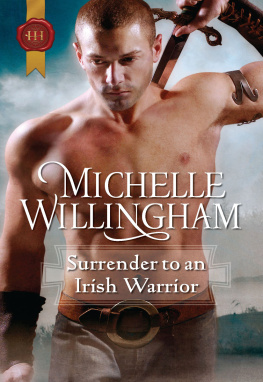


 CONTENTS
CONTENTS